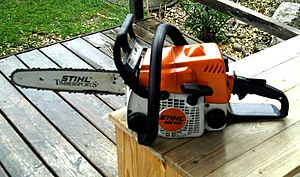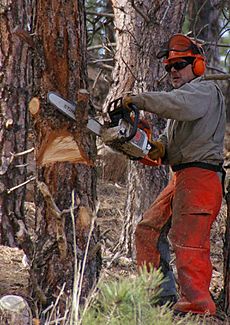Chainsaw facts for kids
A chainsaw is a portable, mechanical saw which cuts with a set of teeth attached to a rotating chain that runs along a guide bar. It is used in activities such as tree felling, limbing, bucking, pruning, cutting firebreaks in wildland fire suppression and harvesting of firewood. Chainsaws with specially designed bar and chain combinations have been developed as tools for use in chainsaw art and chainsaw mills. Specialized chainsaws are used for cutting concrete. Chainsaws are sometimes used for cutting ice, for example for ice sculpture and in Finland for winter swimming. Someone who uses a saw is a sawyer.
Contents
Safety
Despite safety features and protective clothing, injuries can still arise from chainsaw use, from the large forces involved in the work, from the fast-moving, sharp chain, or from the vibration and noise of the machinery.
A common accident arises from kickback, when a chain tooth at the tip of the guide bar catches on wood without cutting through it. This throws the bar (with its moving chain) in an upward arc toward the operator which can cause serious injury or even death.
Another dangerous situation occurs when heavy timber begins to fall or shift before a cut is complete — the chainsaw operator may be trapped or crushed. Similarly, timber falling in an unplanned direction may harm the operator or other workers, or an operator working at a height may fall or be injured by falling timber.
Like other hand-held machinery, the operation of chainsaws can cause vibration white finger, tinnitus or industrial deafness. These symptoms were very common when such equipment was not de-vibrated. On today's equipment there are damping elements (in rubber or steel spring) lowering these risks. Heated handles are an additional help.
The risks associated with chainsaw use mean that protective clothing such as chainsaw boots, chainsaw trousers and hearing protectors are normally worn while operating them, and many jurisdictions require that operators be certified or licensed to work with chainsaws. Injury can also result if the chain breaks during operation due to poor maintenance or attempting to cut inappropriate materials.
Gasoline-powered chainsaws expose operators to harmful carbon monoxide (CO) gas, especially indoors or in partially enclosed outdoor areas.
Drop starting, or turning on a chainsaw by dropping it with one hand while pulling the starting cord with the other, is a safety violation in most states in the U.S. Keeping both hands on the saw for stability is essential for safe chainsaw use.
Parts
A chainsaw has several parts, including:
- Engine — usually a two-stroke gasoline (petrol) internal combustion engine, usually with a cylinder volume of 30-120 cm3 or electric motor.
- Drive mechanism — typically a clutch and sprocket.
- Guide bar — a long bar with a round end of wear-resistant alloy steel usually 16 to 36 inches in length. An edge slot guides the cutting chain.
- Cutting chain — Usually each segment in this chain (which is constructed from riveted metal sections similar to a bicycle chain, but without rollers) features small sharp blades called teeth. The bottom of each link features a small metal finger called a "drive link" which locates the chain on the bar, helps to carry lubrication oil around the bar, and engages with the engine's drive sprocket inside the body of the saw.
As chainsaw carving has become more popular, the makers of chansaws are making special short, narrow-tipped bars for carving. These are called "quarter tipped," "nickel tipped" or "dime tipped" bars, based on the size of the round tip.
Images for kids
-
A professional logger limbing a downed tree
See also
 In Spanish: Motosierra para niños
In Spanish: Motosierra para niños













